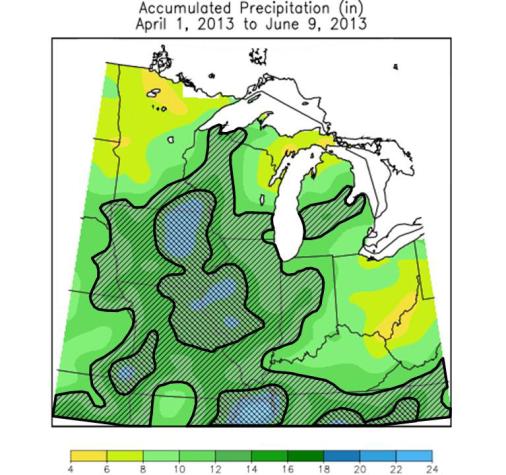COLUMBIA, Mo. – Producers who don’t plan, watch and act for nitrogen deficiencies in their corn will lose green in their crop and at the bank, says a University of Missouri Extension plant scientist.
Peter Scharf said drenching rains have depleted nitrogen fertilizer from the soil, especially anhydrous ammonia applied last fall. That was seven hard months ago. Fall weather was good for field work, so Missouri corn producers applied nitrogen then in larger-than-usual quantities. Those who didn’t apply in the fall had to apply this spring, when it’s been too muddy to work most days. But the risk of losing nitrogen applied in spring is lower.
Snow and rain in February and March began replenishing moisture to drought-stricken soils.
And the rain kept coming. Almost 60 million acres in the Midwest received more than 16 inches of rain between April 1 and June 9, prime planting time. Iowa and Missouri got particularly damp.
When it gets this wet, N-Serve added to fall-applied ammonia doesn’t provide enough protection from nitrogen loss, Scharf said. He suspects that well-drained soils have had the largest losses because the heaviest rains fell during April, when well-drained soils are more vulnerable to loss than poorly drained fields.
As a result, farmers who applied nitrogen before planting should plan how they will apply additional fertilizer and what equipment will be available, he said. Additionally, fertilizer retailers should make plans on how to help customers apply nitrogen to growing corn. Scharf says good options include tractor-driven injection equipment, tractor-drawn dry N buggies, sprayers equipped with drip nozzles, high-clearance self-propelled spinners and airplanes.
One alternative is to use high-clearance fertilizer applicators equipped with canopy sensors to assess nitrogen status. This allows direct on-the-go and spatially variable nitrogen applications, but correct interpretations of the sensor assessment are critical.
Scharf said farmers should visually monitor their corn constantly for light green color, which indicates insufficient nitrogen. If the corn leaves remain light after soil has dried, you need to add more nitrogen. This is most reliable for corn that it at least a foot tall.
Nitrogen stress differs from field to field on the same farm, he said. The best return on the dollar for rescue nitrogen is on fields that look the worst. Fields applied with nitrogen this spring or after planting are less likely to need more nitrogen, but producers should keep a watchful eye.
Scharf also cautions that it is difficult to monitor corn from ground level. Views and photos from airplanes afford a more accurate assessment. He said many airfields have local pilots for hire.
He said he could predict yield loss from a straight-down aerial photo of corn that is at least hip-high. Anyone interested in this service may contact Scharf at 573-882-0777.
Producers can track rainfall and risk of nitrogen loss in the state and region on MU’s Nitrogen Watch website. To access the website go to plantsci.missouri.edu/NutrientManagement.
